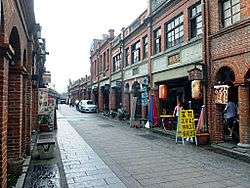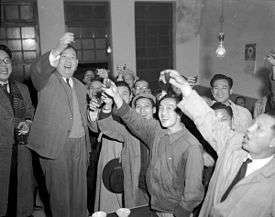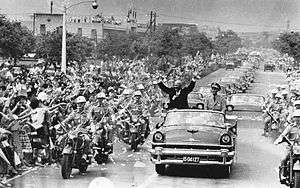History of Taipei
Part of a series on the |
||||||||||||||||
|---|---|---|---|---|---|---|---|---|---|---|---|---|---|---|---|---|
| History of Taiwan | ||||||||||||||||
 | ||||||||||||||||
| Chronological | ||||||||||||||||
|
||||||||||||||||
| Topical | ||||||||||||||||
| Local | ||||||||||||||||
| Lists | ||||||||||||||||
|
| ||||||||||||||||
The recorded history of Taipei began with the Han Chinese settling of the Taipei Basin in 1709, leading up to the formation of the national capital of Taiwan and high-tech industry hub and that is now Taipei City. Other notable dates include the 1895 annexation of Taiwan by Japan, during which Taipei began to grow more rapidly, and in the 1950s, the USA's provision of financial assistance to the Republic of China government, after which the city continued on a path of fast structural and industrial growth.
First settlement
The region known as the Taipei basin was home to Ketagalan tribes before the 18th century. Han Chinese began to settle in the Taipei Basin in 1709.
By the late 19th century, the area of present-day Taipei was home to northern Taiwan's major Han settlements, in addition to the government-designated foreign trade port of Tamsui. The Taipei area's economic importance grew with increases in foreign trade, especially that related to tea exportation.
First Chinese official development
In 1875, the northern part of Taiwan was separated from Taiwan Prefecture and incorporated into the new Taipeh Prefecture. Having been established adjoining the flourishing townships of Bangkah and Twatutia, the new prefectural capital was known as Chengnei (Chinese: 城內; pinyin: chéngnèi; Pe̍h-ōe-jī: siâⁿ-lāi; literally: "walls-inside"). Administratively, the area was part of Tamsui County (modern-day Tamsui District) and the prefectural capital. In 1879, a prohibition against the planting of rice within the marked city limits was issued, and a portion of the land was designated for official purposes. The remaining portions were offered for sale for building purposes. By the end of 1879, the four city gates were almost complete, an Examination Hall was entirely completed, and the Confucian Temple and the Prefect's Yamen were under construction. All wealthy Chinese were compelled to contribute funds, but a large amount came from successful landowner "Lim Pan-ban", of the wealthy Banqiao Lin Family.[1][2]
In 1885, work started to create an independent Taiwan Province, which was officially declared in 1887. The capital of the island, or Taiwan-fu, was intended to be moved from the south to the center of the island, but was temporarily moved north to Taipei.[3]
The temporary capital of the new province was placed at Taipehfu. No sooner had this been decided upon than the city began to assume a new appearance, reflecting the energetic spirit of the governor. In 1885, the work of reconstruction commenced. A substantial wall was built to surround the city, streets were rearranged and paved with stone. A capacious yamen was constructed and the streets lit with electricity; this, we believe, being the first instance of the official adoption of electricity in any part of the empire. It was later found, however, that the system was too expensive, and, with the exception of the yamen, which continued to be thus illuminated, the lights were withdrawn.— J. W. Davidson, [4]
A new railway connecting the cities of Keelung and Taipei (see Taiwan Railways Administration) became the earliest railroad system in China. However it did not achieve the original intent of connecting the new provincial capital in central Taiwan to a coastal port such as Keelung in the north due to construction delays. The authorities also had difficulty subduing the aboriginal population in central Taiwan. Taipei remained the provincial capital until the Japanese takeover in 1895.
Japanese rule and leadership

As settlement for losing the Sino-Japanese War, China ceded the entire island of Taiwan to Japan in 1895. During the Japanese era, Taipei, called Taihoku in Japanese, emerged as the political center of the Japanese Colonial Government. In less than a decade after the cession, Taihoku was one of the few places in the island that had already gone from a thoroughly Chinese appearance to "a thoroughly Japanese city in every respect."[5] Much of the architecture of Taipei dates from the Japanese era, including the Presidential Building which was the Office of the Governor-General of Taiwan.
In the early 20th century, a multitude of names were used to refer to the city and its suburbs. Taihoku proper was the part of the city within the city walls; the population was about 9,000,[6] and the area was mainly occupied by Japanese officials and military. Twatutia (Daitōtei in Japanese, population 41,716) was outside the walls, where European settlers lived. It stretched northward along the Tamsui River, which flows down to the port, a distance of about 10 miles (16 km). Bangkah (Banka in Japanese, pop. 27,332) was inhabited by both Japanese and Chinese with a Chinese majority. The total population of all three cities combined was over 86,000 (non-military), 83% Chinese and 17% Japanese.[7]
In 1901, Taihoku Chō (臺北廳) was one of twenty districts established, and with a population of over 294,000, was the most populous district in the 1904 census.[8] Taihoku was incorporated in 1920 as part of Taihoku Prefecture. It included Bangkah (now Wanhua), Twatutia, and Jōnai (城內) among other small settlements. The eastern village Matsuyama (松山庄, now Songshan and Xinyi District) was annexed into Taihoku City in 1938.
Nationalist rule


Upon the Japanese defeat in the Pacific War and its consequent surrender in August 1945, Taiwan was taken over by Chinese Nationalist troops. Subsequently, a temporary Office of the Taiwan Province Administrative Governor (臺灣省行政長官公署) was established in Taipei City. In 1947 the KMT government under Chiang Kai-shek declared island-wide martial law in Taiwan as a result of the February 28 Incident, which began with incidents in Taipei but led to an island-wide crackdown on the local population by forces loyal to Chiang.
On December 7, 1949, the Kuomintang (KMT) government under Chiang Kai-shek established Taipei as the provisional capital of the ROC after the Communists forced them to flee mainland China. Taipei was also the capital of Taiwan Province until the 1956 when the provincial administration was moved to Chunghsing Village in central Taiwan. However, the PRC does not recognize this move and still regards Taipei as the provincial capital of Taiwan.
As approved on December 30, 1966 by Executive Yuan, Taipei became a centrally administered municipality on July 1, 1967. In the following year, Taipei City expanded again by annexing Shilin, Beitou, Neihu, Nangang, Jingmei and Muzha. In 1990, 16 districts in Taipei City were consolidated into the current 12 districts.
New Taipei residents
After the 1990s, after two decades of building urban underground railway traffic, fast roads and early Taipei MRT network, such as bus lanes, had to be completed to a considerable extent relieve the pressure on traffic. In addition, Taipei has continued to construct a more convenient environment of Humanities and Education, and in a more open public conceptualism, and gradually establish a service-based, and diversity goals towards the development of the city forward. After a few years into the 21st century, the Taipei though after the ruling party, have occurred in 1997 murder of Pai Hsiao-yen's security crisis, the collapse of the East Star Building 921 earthquake events in 1999, 2001 Typhoon Nari loss of hundreds of millions of dollars, 2002 Taipei drought and water crisis of 2003 SARS crisis and other major livelihood events, but does not affect the Taipei city into an international process.
For the purposes of the expansion will be a whole, the highest in eastern Taipei, Taipei 101 as the main landmarks Xinyi District started its rapid development, has become the premier central business district of Taipei, the Taring. On the other hand, while actively internationalization, Taipei began to have cognitive and cultural value of traditional architecture. After 2000, Taipei, paying attention to the content and quality of the culture of Taiwan, and began to promote a culture of equality and the right to reproduce the historical memory, emphasizing traditional common people, and promote cultural industries, promote learning and release the Taipei government resources, and create a new culture of meteorological Taipei.
See also
| Wikimedia Commons has media related to History of Taipei. |
References
- ↑ Davidson (1903), p. 211.
- ↑ Davidson (1903), p. 281. identified as "Liu [sic] Wei yuan", see 林維源
- ↑ Davidson (1903), pp. 244-5: "As a result of these changes and additions, the seat of government (which had been formerly at the old town of Taiwan-fu in the south, which city had been in turn the capital of the Dutch, Koxinga, and the Chinese,) was now removed temporarily to the new city of Taipeh, which had been lately in course of construction...In connection with this, it is necessary to go further and explain that it was the intention of the government to build a new capital city in the centre of the island near Changwha."
- ↑ Davidson (1903), pp. 246-7.
- ↑ Davidson (1903), p. 593-4.
- ↑ Takekoshi (1907), p. 200.
- ↑ Chamberlain, B.; Mason, W.B. (1903). A Handbook for Travellers in Japan (7th ed.). London: J. Murray. p. 550. OL 25302448M.
- ↑ Takekoshi (1907), p. 199.
Bibliography
- Davidson, James W. (1903). The Island of Formosa, Past and Present : history, people, resources, and commercial prospects : tea, camphor, sugar, gold, coal, sulphur, economical plants, and other productions. London and New York: Macmillan & co. OL 6931635M.
- Takekoshi, Yosaburō (1907). "Chapter XIII: Population and future development of the island resources". Japanese rule in Formosa. London, New York, Bombay and Calcutta: Longmans, Green, and co. OCLC 753129. OL 6986981M.